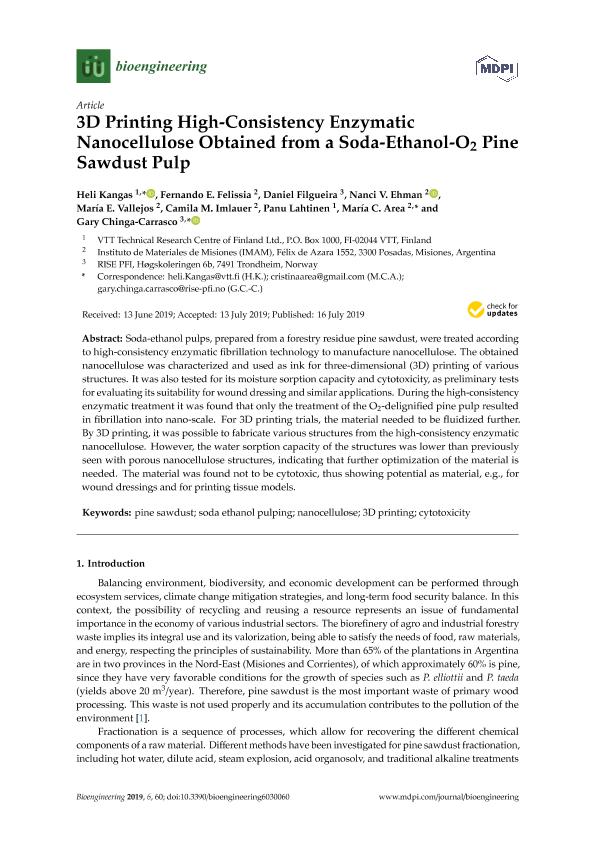Artículo
3D printing high-consistency enzymatic nanocellulose obtained from a soda-ethanol-O2 pine sawdust pulp
Kangas, Heli; Felissia, Fernando Esteban; Filgueira, Daniel; Ehman, Nanci Vanesa ; Vallejos, María Evangelina
; Vallejos, María Evangelina ; Imlauer Vedoya, Camila María
; Imlauer Vedoya, Camila María ; Lahtinen, Panu; Area, Maria Cristina
; Lahtinen, Panu; Area, Maria Cristina ; Chinga Carrasco, Gary
; Chinga Carrasco, Gary
 ; Vallejos, María Evangelina
; Vallejos, María Evangelina ; Imlauer Vedoya, Camila María
; Imlauer Vedoya, Camila María ; Lahtinen, Panu; Area, Maria Cristina
; Lahtinen, Panu; Area, Maria Cristina ; Chinga Carrasco, Gary
; Chinga Carrasco, Gary
Fecha de publicación:
07/2019
Editorial:
Molecular Diversity Preservation International
Revista:
Bioengineering
ISSN:
2306-5354
e-ISSN:
2306-5354
Idioma:
Inglés
Tipo de recurso:
Artículo publicado
Clasificación temática:
Resumen
Soda-ethanol pulps, prepared from a forestry residue pine sawdust, were treated according to high-consistency enzymatic fibrillation technology to manufacture nanocellulose. The obtained nanocellulose was characterized and used as ink for three-dimensional (3D) printing of various structures. It was also tested for its moisture sorption capacity and cytotoxicity, as preliminary tests for evaluating its suitability for wound dressing and similar applications. During the high-consistency enzymatic treatment it was found that only the treatment of the O2-delignified pine pulp resulted in fibrillation into nano-scale. For 3D printing trials, the material needed to be fluidized further. By 3D printing, it was possible to fabricate various structures from the high-consistency enzymatic nanocellulose. However, the water sorption capacity of the structures was lower than previously seen with porous nanocellulose structures, indicating that further optimization of the material is needed. The material was found not to be cytotoxic, thus showing potential as material, e.g., for wound dressings and for printing tissue models.
Palabras clave:
PINE SAWDUST
,
SODA ETHANOL PULPING
,
NANOCELLULOSE
,
3D PRINTING
,
CYTOTOXICITY
Archivos asociados
Licencia
Identificadores
Colecciones
Articulos(IMAM)
Articulos de INST.DE MATERIALES DE MISIONES
Articulos de INST.DE MATERIALES DE MISIONES
Citación
Kangas, Heli; Felissia, Fernando Esteban; Filgueira, Daniel; Ehman, Nanci Vanesa; Vallejos, María Evangelina; et al.; 3D printing high-consistency enzymatic nanocellulose obtained from a soda-ethanol-O2 pine sawdust pulp; Molecular Diversity Preservation International; Bioengineering; 6; 3; 7-2019; 60-72
Compartir
Altmétricas



